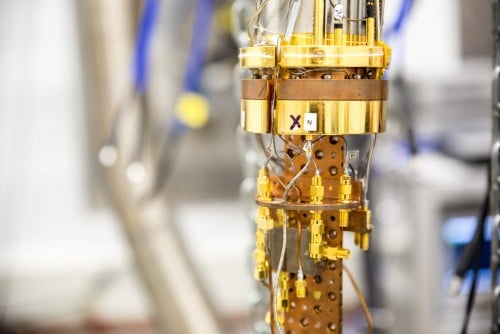Science
Time Crystals Break Ground in Quantum Computing Advancements

A team of researchers at Aalto University has made a significant breakthrough in quantum computing by successfully connecting a time crystal to an external system. This innovative work could enhance the performance of quantum computers and sensing technologies, marking a pivotal moment in the field of quantum physics.
Time crystals, first proposed by Frank Wilczek in 2012, are quantum systems that maintain a perpetual state of motion without requiring external energy. They exist in their lowest energy state, which enables them to repeat movements indefinitely. The existence of time crystals was experimentally confirmed in 2016, but their practical application remained largely unexplored until now.
In a study published on October 16, 2023, in the journal Nature Communications, the research team, led by Academy Research Fellow Jere Mäkinen, transformed a time crystal into an optomechanical system. This advancement has the potential to facilitate the development of highly accurate sensors and memory systems for quantum computers, significantly boosting their computational capabilities.
Connecting Time Crystals to External Systems
The researchers achieved this connection for the first time by employing radio waves to introduce magnons into a superfluid Helium-3, cooled to near absolute zero. Magnons, which are quasiparticles formed from groups of particles, were pumped into the system, where they formed a time crystal that remained in motion for an unprecedented duration of up to 10^8 cycles, or several minutes, before fading.
During the fading process, the time crystal established a connection with a nearby mechanical oscillator, influenced by the oscillator’s frequency and amplitude. Mäkinen explained, “We showed that changes in the time crystal’s frequency are completely analogous to optomechanical phenomena widely known in physics. These phenomena are utilized, for instance, in detecting gravitational waves at the Laser Interferometer Gravitational-Wave Observatory in the U.S.”
The team’s findings suggest that by minimizing energy loss and enhancing the frequency of the mechanical oscillator, their setup could be optimized to operate near the quantum realm. This development opens up new avenues for increasing the efficiency and sensitivity of quantum technologies.
Implications for Quantum Computing
The potential applications of time crystals in quantum computing are substantial. Mäkinen noted that “time crystals last for orders of magnitude longer than the quantum systems currently used in quantum computing.” This longevity could allow them to serve as memory systems, vastly improving the performance of quantum computers. Furthermore, they could function as frequency combs, which are crucial in high-sensitivity measurement devices.
The research was conducted using the facilities of the Low Temperature Laboratory, part of OtaNano, Finland’s national research infrastructure dedicated to nano-, micro-, and quantum technologies. The team also leveraged the computational resources of the Aalto Science-IT project to support their findings.
As quantum technologies continue to evolve, the integration of time crystals may represent a transformative step toward unlocking new capabilities in computation and sensing, paving the way for future innovations in the field.
-

 Science2 months ago
Science2 months agoUniversity of Hawaiʻi Joins $25.6M AI Project to Monitor Disasters
-

 Business2 months ago
Business2 months agoForeign Inflows into Japan Stocks Surge to ¥1.34 Trillion
-

 Top Stories2 months ago
Top Stories2 months agoBOYNEXTDOOR’s Jaehyun Faces Backlash Amid BTS-TWICE Controversy
-

 World2 months ago
World2 months agoBoeing’s Merger with McDonnell Douglas: A Strategic Move Explained
-

 Top Stories2 months ago
Top Stories2 months agoCarson Wentz Out for Season After Shoulder Surgery: Urgent Update
-

 Entertainment2 months ago
Entertainment2 months agoSydney Sweeney Embraces Body Positivity Amid Hollywood Challenges
-

 Top Stories2 months ago
Top Stories2 months agoMarc Buoniconti’s Legacy: 40 Years Later, Lives Transformed
-

 Lifestyle2 months ago
Lifestyle2 months agoKelsea Ballerini Launches ‘Burn the Baggage’ Candle with Ranger Station
-

 Health2 months ago
Health2 months agoInnovative Surgery Restores Confidence for Breast Cancer Patients
-

 Sports2 months ago
Sports2 months agoSteve Kerr Supports Jonathan Kuminga After Ejection in Preseason Game
-

 Entertainment2 months ago
Entertainment2 months agoZoe Saldana Advocates for James Cameron’s Avatar Documentary
-

 Science2 months ago
Science2 months agoChicago’s Viral ‘Rat Hole’ Likely Created by Squirrel, Study Reveals









